Siderates: phacelia, lupine, mustard ... planting, growing
Green manure - plants that are grown before planting the main crop, to enrich the soil with useful elements. They are renew humus reserves, improve the structure, increase the fertility of the upper arable layer.
These plants are undemanding and cold hardy, so they can be planted even in early spring and autumn. In some areas of the country, green manure is planted in early October, and before the onset of cold weather, they manage to build up the necessary green mass. There are a lot of ways to use this "green manure". This type of plant reduces the acidity of the soil, helps to accumulate useful macroelements in the upper horizons, and accelerates microbiological processes.
Siderates are planted for:
- Soil fertilizers;
- Qualitative structuring of the soil layer;
- Shading young plantings;
- Cleaning the land from weeds;
- Protection of plants from insect pests;
- Restoring soil that has been eroded.
Features of the use of green manure
If you do not know how to properly use "green fertilizers", you can make a number of mistakes that will negate all the efforts made.
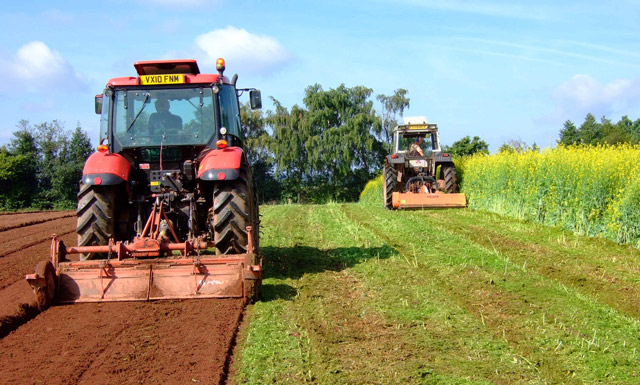
In order not to be disappointed in this method of enriching the soil with useful substances, it is advisable to adhere to the following rules:
- Siderates must be mowed on time, otherwise the stems will coarsen and rot in the ground for a long time. Half-decayed biomass can become a source of viral and fungal diseases.
- It is not worth waiting for the plants to grow to their maximum volume. An excess of nitrogen in the soil can cause the roots of the crop planted next to begin to "burn".
- To protect the beds from weeds, green manure must be sown in bulk, not in rows.
- The tops of these plants need to be trimmed two weeks before planting the main crop.
- Plants belonging to the same family as green manure should not be planted next to them, since common pests could remain in the ground.
- If the goal is to restore the soil, then "green fertilizers" must be cut with a scythe or flat cutter without damaging their root system.
- Do not mow winter siderats planted in late autumn before frosts. Leave them until next spring. In this case, you don’t have to plow the land, it will already be very loose.
The technology of improving the soil with the use of biohumus is increasingly being used in personal gardens, and in large agricultural holdings. It includes many different points, but the main principles of this concept are respect for the earth and the use of vegetable fertilizers.
The most common green manure plants are white mustard, rye, oats, lupins, phacelia, vetch and rapeseed. The features of the application of each of them will be discussed below.
Phacelia
The biggest advantage of this siderate is that after it, you can plant any crop. Phacelia belongs to the gimlet family, to which none of the cultivated plants of the middle zone belongs. It can be sown before and after any vegetables, cereals and herbs. Application rates - 8-10 g / sq.m. Due to the "class affiliation", this plant is suitable for fertilizing land for radishes, turnips, as they are most often affected by pests.
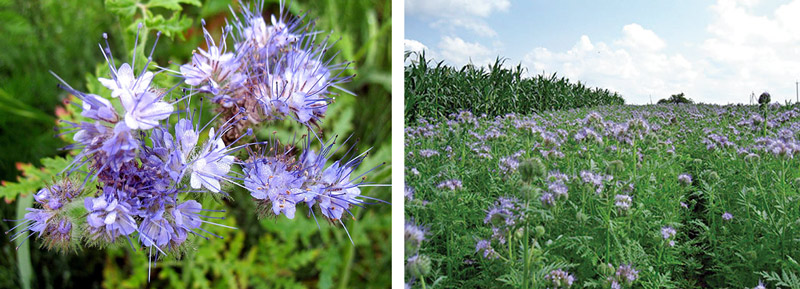
Phacelia sprouts and develops very quickly (45-55 days), forming lush bunches of greenery growing from one root. In the shape of the aerial part, it got its name, since in Latin, Phacelia is a bunch. Outwardly, she looks very attractive. Purple flowers and carved leaves look decorative and would be appropriate for filling empty spaces in garden beds, flower beds and high ridges.
Embedded in the soil, phacelia increases its fertility no less than cow dung. The introduction of tops into the soil (about 100 kg/hundred) is equivalent to the use of 1 ton of humus on the same plot of land. But vegetable biomass can be prepared much faster, and it will cost less than organic fertilizers of animal origin.
Another very useful property of this flower, which is not found in other plants belonging to the conditional class of "green fertilizers" - its nectar attracts entomophages that destroy insect pests. Codling moths, aphids and leafworms disappear from the plot. Phacelia is often planted as a protective barrier for, in order to protect plantings from pests. The wireworm does not tolerate neighborhood with it, and locusts and soil nematodes simply die when inhaled by the fungicides emitted by its flowers. At the same time, this flower does not have a negative effect on bees, and is an excellent honey plant. Some beekeepers specially plant whole plantations of phacelia to get flower honey with excellent taste.
How to grow phacelia seeds?
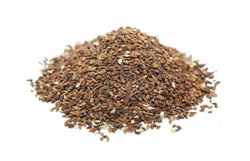 Phacelia is the best green manure in terms of versatility of use. Therefore, many summer residents want to see her on their site. But its seeds are expensive. And one of the most important advantages of using bio-humus is the low cost of use. If this factor is offset by the high cost of seeds, then there is no point in sowing this plant.
Phacelia is the best green manure in terms of versatility of use. Therefore, many summer residents want to see her on their site. But its seeds are expensive. And one of the most important advantages of using bio-humus is the low cost of use. If this factor is offset by the high cost of seeds, then there is no point in sowing this plant.
Many summer residents have learned to get around this obstacle by growing seeds on their own. To do this, they leave a plot, away from the garden, so that the ripening seeds do not fall on the beds. Then they wait until the flowers fall from most of the spikelet. The stems are cut and dried in a closed, well-ventilated area with low humidity. Well-dried phacelia is threshed, and excellent seed material is obtained, which is in no way inferior to store-bought counterparts.
Mustard white
This cold-resistant green manure can be grown and embedded in the ground several times per season. The last time it is planted before winter, a few weeks before the onset of cold weather. They do this so that the green mass is “beaten” with cold, and it would remain to rot under a layer of snow. The processes of decay will continue for some time after the onset of negative temperatures, due to the internal heat released during the decomposition of plant organic matter. It is enough to turn green manure fertilizers into humus, which is very useful for plants in the spring.
It sprouts amicably, and very quickly gains vegetative mass. It is very important not to "miss" the moment when the stems begin to harden. Greens must be mowed before it turns yellow, before the first flowers appear, as soon as the first ovaries of buds have poured.

The minimum period from sowing to incorporation of this plant into the soil is five weeks., but if possible, it is better to wait for all eight. When calculating the timing of harvesting, it should be borne in mind that in hot weather the stems harden faster, in cold weather - slower, so in autumn and spring you can leave the greens in the beds for a long time.
Mustard is usually sown "scattered", except when it is used to protect plants from pests. Then the in-line method is applied. The consumption rate of seeds of this fertilizer is 4-7 g per 1 sq.m. If you sow more, then the plantings will thicken, and rotting of greenery on the vine may begin.
To accelerate the maturation of plant humus, the green mass obtained from mustard plantings can be watered with a biostimulant. For this purpose, it is perfect, which is diluted in a ratio of 1: 1000 (a drop per liter of water), and the mowed grass is sprayed with a spray bottle. Under the action of live bacteria contained in the preparation, the grass rots faster and becomes part of the soil system.
Video: mustard and other green manure - planting and result
Lupine
One of the oldest green manure in the history of agriculture is the common lupine. To enrich the soil, poor in nitrogen, it was used in Greece, more than two thousand years ago. Gardeners completely buried the trunk and leaves without roots in the near-stem circle of the fruit tree, and there was enough nitrogen for several months.
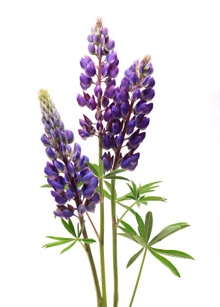
This plant belongs to the legume family, respectively, beans, peas and beans cannot be planted after it, these crops have common pests. Excellent followers for lupine will be, cabbage,. And for potatoes, this beautiful flower will be the best predecessor.
The powerful roots of the plant are an active baking powder, penetrating deep into the soil. In parallel, they have another positive effect - they saturate all soil horizons with nitrogenous bacteria. Plantings of lupine are capable of accumulating about 200 kg of nitrogen per 1 hectare in the ground.
This green manure is planted in early spring, in a row. Seed consumption (and they are quite large) - 4-5 per sq.m. When the lupine reaches the age of 5-7 weeks, its tops are plowed into the ground. Even if it bloomed, it's not scary, the most important thing is to prevent the formation of seeds, since at this stage of plant development the stem becomes stiff and rots poorly in the soil.
The great advantage of the plant can be considered a tap root system, which goes deep into the ground, and receives most of the nutrients from the deep layers, without impoverishing the upper fertile layer. At the same time, biohumus obtained from the aerial parts of lupine, per 1 sq.m. replaces 4 kg of manure, or 40-50 g of urea.
Rye
In many regions of the country, it is customary to sow a garden with this cereal after digging potatoes. Rye bushes well and grows a large green mass, reaching 200-300 kg per hundred square meters. This green manure is planted both before winter and in spring, planting time does not affect its quality. The special value of winter rye lies in the fact that it actively increases biological mass even at rather low temperatures, and winter crops survive even in snowless winters, with frosts down to -25°C.

The disadvantage of all cereals grown to enrich the soil, including rye, is the complexity of their subsequent processing and plowing.. The stems have a fairly strong structure, decompose for a long time, and cling to the plow shares, which have to be cleaned all the time. Another disadvantage of this winter green manure is that it dries up the soil a lot, so rye cannot be sown between trees in the garden.
Otherwise, this cereal crop is an excellent fertilizer, whose seeds are inexpensive, and therefore available to everyone. Rye is undemanding to the quality and thickness of the soil layer, perfectly sods loose soils, easily puts up with high acidity. Since this plant has a fibrous root system, it easily retains nutrients in the upper soil horizon, preventing them from being washed away with melt water and rainwater.
A big plus of this green manure fertilizer is that when it decomposes, it saturates the soil not only with nitrogen, but also with calcium. Microorganisms contained in cereal biomass create conditions for the absorption of phosphorus compounds that are difficult to digest, dissolving them. Accordingly, a complete NPK-complex of nutrients remains in the ground, which allows any successor crops to fully develop.
The aerial part of cereals after cutting is used not only for plowing. The resulting straw is used as mulch. It provides excellent protection of the soil from drying out, and does not allow weed seeds to break through to the surface. Subsequently, decomposing, fresh straw becomes part of the garden, turning into biohumus.
oats
This cereal crop is used as green manure less often than rye. But this is more a coincidence than a pattern. The plant has all the positive qualities of rye, while it also outperforms it in some respects. For example, oats are even more unpretentious. It can be sown on acidic podzolic soil, clay, and even peat bog - it will grow anywhere.
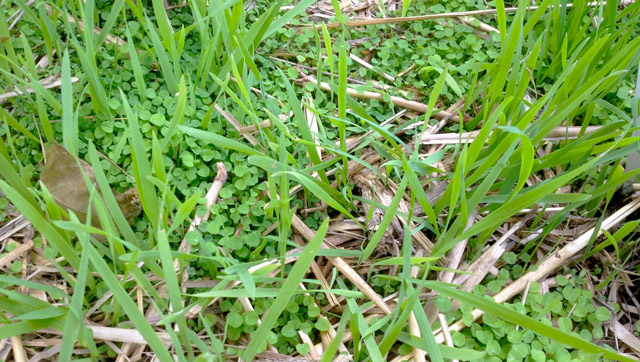
Oat green manure combined with clover
As part of a crop rotation, it is sown after legumes, preparing the land for potatoes. Despite the apparent weakness of the fibrous root system, this plant perfectly loosens the earth to a great depth, enriching it with oxygen, and creating a structure that is comfortable for cultivated plants. Oats saturate the upper soil layer with nitrogen and potassium, and, like rye, decompose difficult-to-digest phosphorus compounds.
The seeds of this crop are planted, scattering them over the surface of a previously loosened piece of land, in early spring, as soon as it is possible to enter the garden. Do not be afraid of dirt and cold - oats love them, and these parameters do not affect its germination. On the contrary, in late March - early April, optimal conditions are created for the germination of oats, since it will be able to feed on soil moisture from melted snow. The sowing rate is 1.5-2.1 kg per hundred square meters, the seed placement depth is 4-5 cm.
Growing potatoes in oats
Agricultural technologies, like any other, do not stand still. In modern horticulture, the technology of growing crops without prior plowing of the land is increasingly being used. It allows you to save not only time and effort, but also to get excellent yields. Green manure, as part of the no-till farming culture, is actively used in this system.
Oats can be not only a supplier of biohumus. His can be used for potatoes by growing tubers in oat straw mulch. Moreover, in the plot that is planned for this crop, you don’t even have to remove the grass, it will disappear by itself, turning into the composition of the nutrient soil. It only needs to be slightly pushed apart, and in the intervals make grooves into which oats are planted.
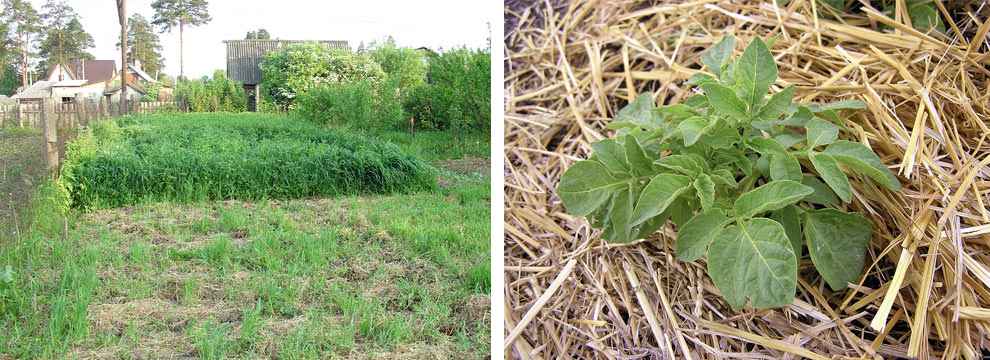
When green manure and weeds grow enough, they are cut under the root with a flat cutter, and, having made a small depression in the soil, they plant potatoes there, lightly sprinkling it with a layer of earth. The sprouts that appear are mulched with straw and grass, and when they become very large, other green waste is gradually added, for example, grass left after mowing the lawn. Most importantly, it is necessary to block access to the tubers of the sun's rays, which will "green" them, making the potatoes unsuitable for eating.
After the autumn harvest of potatoes, which, by the way, will be a very clean and fast process, the field must be re-sown with oats, and continue to do this every year. After a couple of years without digging, the soil structure will be completely restored, and this piece of land will produce consistently high yields.
Vika
Vika (mouse peas) is an early maturing plant, and has a short growing season, which allows it to be used as an intermediate crop between plantings of the main crops. For example, it can be planted in beds intended for seedlings of tomatoes, peppers and eggplant. Before gourds, it can also be sown. Pumpkin, zucchini, squash planted "on the vetch" give excellent harvests.
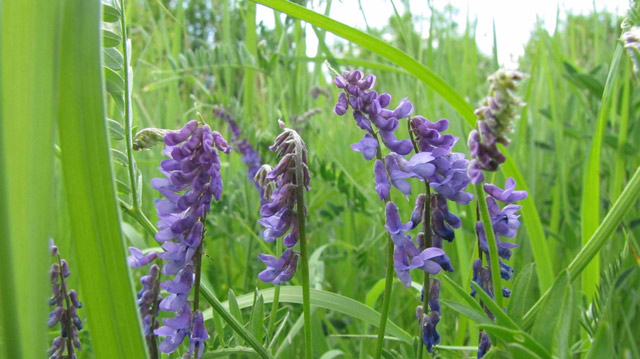
Green manure planting is carried out throughout the growing season, as soon as positive temperatures are established. The sowing rate is 1.5 kg per one hundred square meters. The depth of seed placement is 1-3 cm. It is not necessary to go deeper, otherwise the plant will not be able to penetrate the surface layer of the soil. To speed up the emergence of seedlings, the plot can be watered with EM fertilizers, this is cheap and fast.
Vetch is often included in a mixture that includes green manure plants such as rye, oats, rapeseed and ryegrass. This is done to obtain the optimal composition of biohumus, which is formed after mowing these crops, since this plant accumulates mainly nitrogen. "Mouse peas" belong to the legume family, and, accordingly, has a similar structure. The same nitrogenous nodules are formed on its roots, which accumulate this element. Peas, beans and beans cannot be planted after it. But potatoes, cabbage, radishes, and greens will be excellent subsequent crops.
sweet clover
Previously, this herbaceous plant was used as a fodder crop for livestock. But then they noticed that when plowing the mowing, where the sweet clover grew, the land gave richer crops than in the fields that were sown with other herbs. After that, sweet clover began to be used as green manure. It is a biennial plant that is grown as an annual. Sweet clover is unpretentious, hardy and grows rapidly. It belongs to the legume family, so it can accumulate nitrogen in the root system. Its roots penetrate deep into the earth, and have a large number of branches. Thanks to the powerful root system of this plant, after cutting it, the earth does not need to be dug up. It will be loose without additional processing.
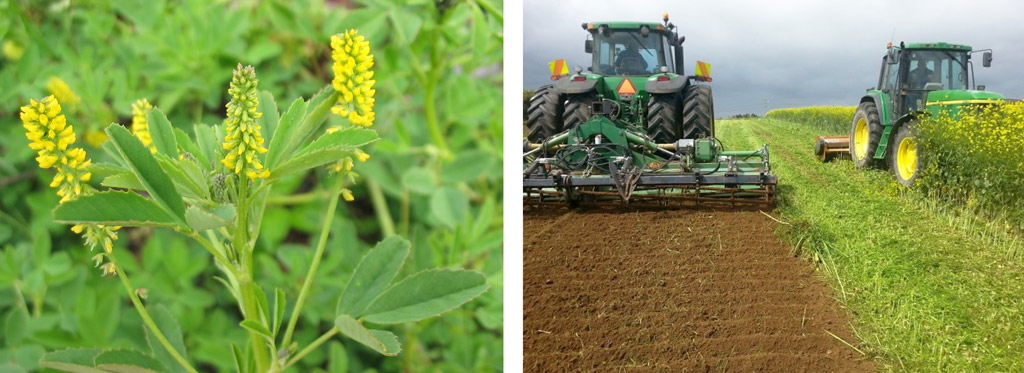
A feature of growing sweet clover is that it is considered the most useful not above-ground, but underground part. Therefore, you can cut the plant already 3-4 weeks after the emergence of shoots. If you let it outgrow, it will become too hard for further processing, and the “pipes” from its stems will stick out of the garden for a couple of seasons, not decorating the garden at all.
radish
Oil radish is a unique siderat, with a rapidly growing aerial part. For 6 - 7 weeks, it can increase its vegetative mass by 4-5 times. Among gardeners, it is popular as a natural "agrokiller". Radish suppresses all weeds, even creeping wheatgrass.
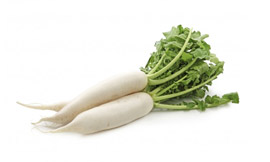 This green manure is not only an active supplier of biomass. Radish is a natural doctor and earth cleaner. She successfully fights diseases such as keel in cabbage, and nematodes. It must be planted on lands that have been affected by various diseases and pests for several seasons, and the soil will become healthy again.
This green manure is not only an active supplier of biomass. Radish is a natural doctor and earth cleaner. She successfully fights diseases such as keel in cabbage, and nematodes. It must be planted on lands that have been affected by various diseases and pests for several seasons, and the soil will become healthy again.
It is best to sow radish on fresh arable land, it loves soft ground. Seed consumption - 300 g per hundred square meters. 4 weeks after the emergence of full shoots, the aerial part of the plant is excised with a shovel, and dug up along with the soil. The thickest stems are best composted.
The use of green fertilizers allows you to restore the soil balance, save money on purchased top dressing, and grow environmentally friendly products. The use of green manure helps to create a new humus layer, which was destroyed during the use of traditional farming, when all nutrients were removed from the soil with the resulting products. The soil enriched by natural methods will be transformed, and will surely thank you for all your efforts with abundant harvests of organic vegetables and fruits.




